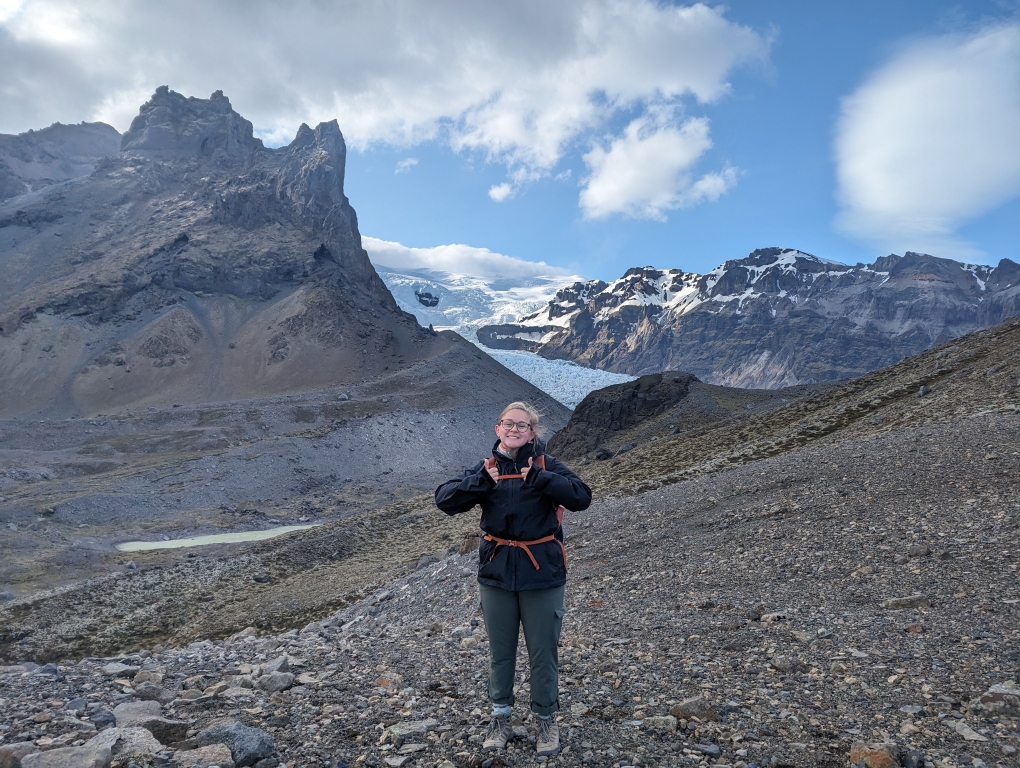
Unearthing Answers By enlisting guidance from the W&L science community, Emma Marvelli ’27 combined a Spring Term abroad class with summer research to better understand Virginia meta-basalts and their potential for combating climate change.
The words “no service” stubbornly remained on the top left corner of both Emma Marvelli ’27 and then-visiting assistant professor of earth and environmental geoscience Karena Gill’s phones, and the gravel road near Panther Falls in Rockbridge County didn’t provide much visual hope of a cellular status change. The Summer Research Scholar and professor were meta-basalt rock hunting at the beginning of April to collect samples for Marvelli’s summer project. And although there were rocks all around them, none were the variety they sought. The GPS, they discovered, had led them astray and not to their desired destination.
The two admit they still might be lost had they not had the foresight to download a map prior to departure. After much analyzing and searching for a “little curvy road,” they finally arrived at the meta-basalt site.
But why so much interest in this particular type of rock?
After geoscience reeled her in following a fall semester class on planetary geology with Gill, Marvelli approached Gill with the desire to perform research involving climate change solutions. And when Marvelli was accepted to join David Harbor, professor of earth and environmental geoscience, for his 2024 Spring Term abroad class, “Regional Geology of Iceland,” she and Gill brainstormed ways to include the Nordic island into their summer research project. They landed on studying Virginia meta-basalt and Icelandic basalt. Basalt is a volcanic rock formed by lava cooling on the Earth’s surface, while meta-basalt is basalt that has undergone metamorphism due to heat and pressure.
“After researching different methods for carbon capture and storage, we decided to conduct a comparative geological analysis, followed by a series of experiments to test their chemical suitability for carbon sequestration, which is the process of capturing and storing carbon dioxide from the atmosphere,” said Marvelli.
The surfaces of basalts have the right chemical composition to facilitate the formation of carbonate minerals, which incorporate carbon dioxide into their chemical structure. When basalts are exposed to carbon-rich waters, such as rainwater, groundwater or seawater, they can capture and convert carbon dioxide into solid carbonate minerals, thereby reducing the amount of carbon dioxide in the atmosphere. This process has been demonstrated in-situ by the CarbFix project, which accelerates the natural process of reactive rock capturing dissolved carbon dioxide – one of the many sustainability initiatives Marvelli studied during the Spring Term.
“Hopefully, it’s a long-term solution for removing carbon dioxide, as carbonate minerals are stable and remain as a part of the geological formation,” Gill said.
With the help of Harbor’s expertise, they chose to study Icelandic pillow basalts, which are formed from underwater volcanic eruptions that produce pillow-shaped bodies of igneous rock that can break open and extrude more lava. Pillow basalts are highly porous and naturally fractured, making them ideal candidates for carbon sequestration – more pores and fractures mean more places for the carbon dioxide to be stored. Marvelli chose the Valahnúkur Tindar on the Reykjanes Peninsula as her sample site.
“Iceland sits on the Mid-Atlantic Ridge, which is a divergent tectonic boundary,” said Marvelli. “It is constantly producing lava and, thus, volcanic rocks such as basalt. Basalt is everywhere in Iceland, and in many different capacities.
“After figuring out where we wanted to collect them, we went through the permitting process,” she added. “And then I came back with a 40-pound suitcase.”
Though Iceland’s basalts have demonstrated potential as a combatant to climate change in previous studies, Appalachia’s samples weren’t automatically going to have the same result. The Appalachian mountain range formed in a convergent zone where tectonic plates collided together, as opposed to Iceland where they are pulling apart. Due to this mountain-building event, the Virginian basalt was metamorphosed into the meta-basalt of the Catoctin Formation, which spans through Virginia, Maryland and Pennsylvania. The Virginian meta-basalt pore spaces have been either squished together or filled with other minerals. Despite that, Marvelli wanted to research if Virginia’s samples could likewise sequester carbon, and if not, or not as well, determine what the characteristics are of Iceland’s samples that make theirs more optimal.
“We’re interested in how the different compositions of meta-basalt versus basalt influence the formation of various carbonate minerals,” Gill said. “If we have this composition in meta-basalt and that composition in basalt, what differences emerge in the types of minerals that form from the solution we introduce? What reactions occur, and how do they differ? Additionally, how much carbonate can precipitate based on the available pores and fractures in these highly porous basalts compared to the less porous meta-basalt?”
A Group Effort
Throughout the spring and summer, the earth and environmental geoscience department – and even those outside of it – offered expertise and guidance. Margaret Anne Hinkle, assistant professor of earth and environmental geoscience, joined the project to help with the geochemistry of the experiments.
“I’m an environmental geochemist; I mostly focus on water quality,” Hinkle said. “But when you step back and think about the biggest issues that are facing us today, climate change really is it. I’ve been thinking for years about how I transition, at least some of my projects, to focusing on climate change. And I think that this is a really great way to meld these fields together.”
Early on, the department connected the researchers with Whit Altman ’05, a project scientist for environmental consulting group SynTerra Corp. Gill and Marvelli also met with individuals from the Virginia Department of Energy (DOE), who are interested in their research on the composition of the rocks and their different elements. The DOE connected them with a researcher at Columbia University working on a carbonate mineralization project, which helped the partners zero in and narrow down their focus and processes.
“Since then, we’ve been working with standard analyses to characterize the samples’ chemical composition, microstructures, porosity and permeability, all of which are important for determining suitability for carbonate sequestration,” said Marvelli. “To identify the minerals present in the samples, we’ve been using the scanning electron microscope and then looking at the energy dispersive X-ray spectrometry and X-ray fluorescence.”
Crossing over from the chemistry department, Erich Uffelman, Bently Professor of Chemistry, taught Marvelli how to use the portable X-ray fluorescence (pXRF) spectrometer to determine the elemental compositions of her samples. A reaction vessel was purchased using funding from the Johnson Opportunity Grant program, which will help Marvelli perform an experiment to see if carbon sequestration occurred after sample exposure to carbonic acid.
“This is not really something I had a lot of experience with — zero experience with,” Marvelli said. “Having the privilege to work with Dr. Gill and Dr. Hinkle has allowed me to work through the processes of research, and I feel that this experience has created a strong foundation for my future career.”
“It’s been great getting to work with everyone,” she added. “I feel that this project has brought much of the W&L scientific community together and fostered campus-wide connections across departments. We’ve worked with chemistry for the pXRF and with physics on our experimental setup. This project could not have been what it is today without the support from everyone.”
In September, Marvelli will present the preliminary findings from her Virginia meta-basalts project at the Geological Society of America conference in California. And she’s continuing her experiments through the academic year – and maybe longer – as she’ll balance independent research with serving as a resident adviser and student-athlete on the track & field team (she’s a hammer thrower) with her normal semester course load.
“Even just having all that experience in the first year of learning about geology, meeting everyone in the department and getting familiar with all the faces, it’s been a very a welcoming and accepting environment,” Marvelli said. “I think that goes to show that there are so many opportunities at Washington and Lee University, and that it truly is a place where you get to work on projects with others and advance your learning through research while also having the ability to work independently and achieve the goals you set for yourself.”
 Visiting assistant professor of geoscience Karena Gill and Emma Marvelli ’27 searched for meta-basalts in Rockbridge County.
Visiting assistant professor of geoscience Karena Gill and Emma Marvelli ’27 searched for meta-basalts in Rockbridge County.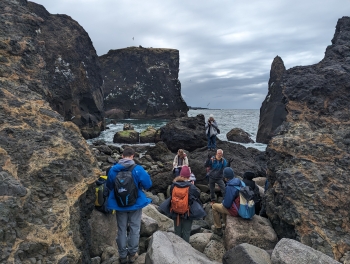 Marvelli incorporated her Spring Term abroad class in Iceland with her summer research.
Marvelli incorporated her Spring Term abroad class in Iceland with her summer research.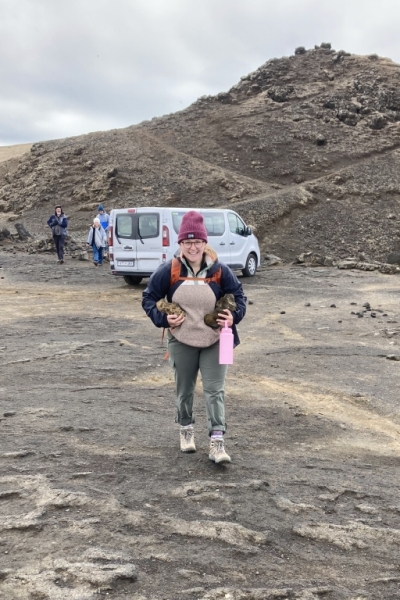 Marvelli collected pillow basalts in Iceland for further study.
Marvelli collected pillow basalts in Iceland for further study. Assistant professor of earth and environmental geoscience Margaret Anne Hinkle and Marvelli, along with Gill (not pictured), have worked in the lab at W&L to compare Icelandic pillow basalts and Virginia’s meta-basalts.
Assistant professor of earth and environmental geoscience Margaret Anne Hinkle and Marvelli, along with Gill (not pictured), have worked in the lab at W&L to compare Icelandic pillow basalts and Virginia’s meta-basalts.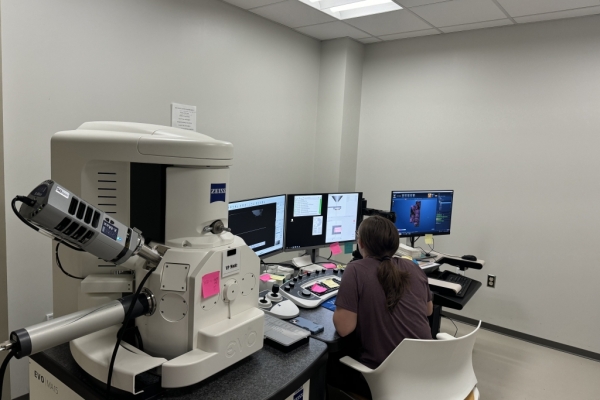 Marvelli used the scanning electron microscope for her summer research.
Marvelli used the scanning electron microscope for her summer research.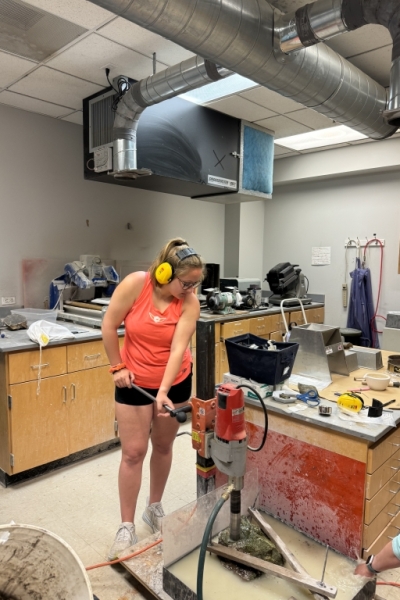 Marvelli used the core machine on her rock samples in the Department of Earth and Environmental Geoscience’s rock prep room.
Marvelli used the core machine on her rock samples in the Department of Earth and Environmental Geoscience’s rock prep room.
You must be logged in to post a comment.